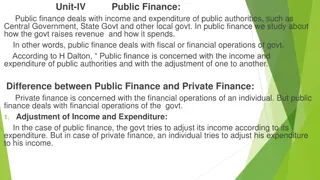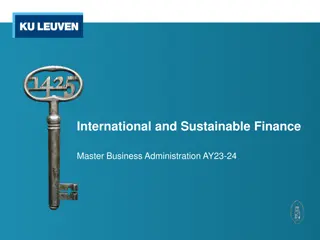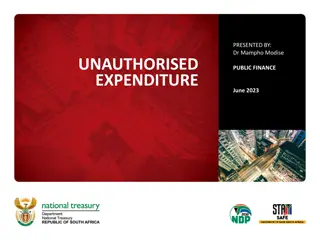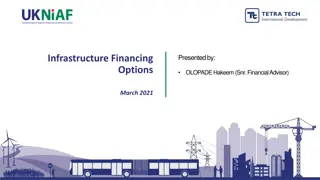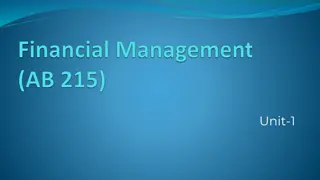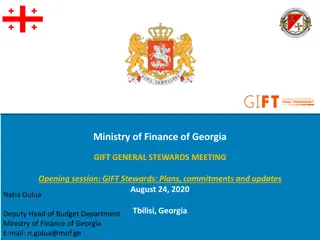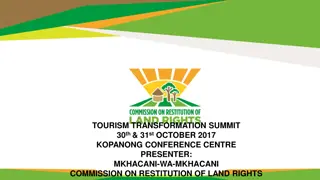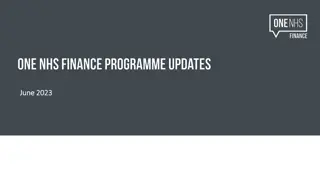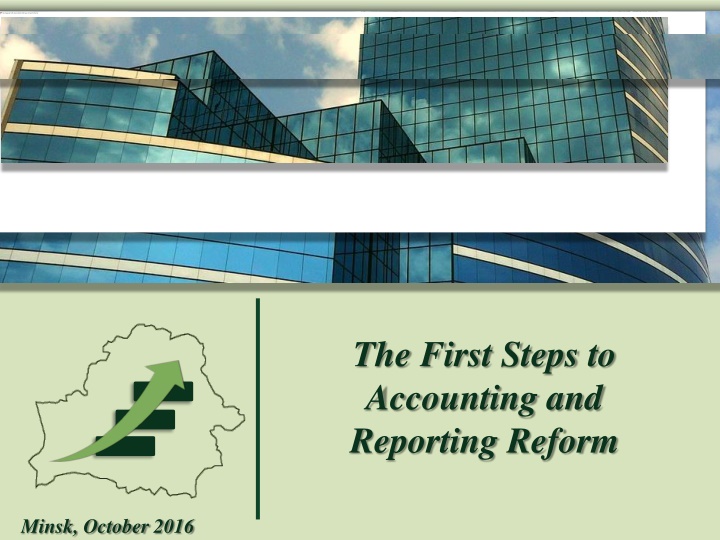
Key Areas of Public Finance Management Reform
In Belarus, the strategy for public finance management reform aims to improve budget feasibility, transparency, and control. Key areas include budget development, accounting system enhancement, and internal financial control organization. The Automated System for Financial Settlements (ASFS) plays a vital role in budget drafting, revenue forecasting, and debt management. However, drawbacks such as decentralization and outdated technologies hinder efficient budget execution. Addressing these issues is crucial for achieving long-term budget sustainability and enhancing public finance management quality.
Download Presentation

Please find below an Image/Link to download the presentation.
The content on the website is provided AS IS for your information and personal use only. It may not be sold, licensed, or shared on other websites without obtaining consent from the author. If you encounter any issues during the download, it is possible that the publisher has removed the file from their server.
You are allowed to download the files provided on this website for personal or commercial use, subject to the condition that they are used lawfully. All files are the property of their respective owners.
The content on the website is provided AS IS for your information and personal use only. It may not be sold, licensed, or shared on other websites without obtaining consent from the author.
E N D
Presentation Transcript
The First Steps to Accounting and Reporting Reform Minsk, October 2016
Strategy of the Belarus public finance management reform (as defined by Resolution of the Council of Ministers of the Republic of Belarus No. 1080 of 23.12.2015) provide for long- term balance and sustainability of the budget system, raise the public finance management quality Main goal
Key areas of the public finance management reform: 1. Improve the budget feasibility and development in conformity with the policy goals 2. Achieve budget completeness and transparency 3. Predictability and control in the budget execution process 4. Improve the accounting and reporting system in the general government sector 5. Apply a breakthrough approach to the internal financial control organization 6. Develop a new integrated information system of public finance management
Key tasks of the Automated System for Financial Settlements (ASFS) Budget drafting Quarterly budget allocations Budget adjustments Forecasting, planing and balancing budget revenue and expenditure Budget development Expenditure budget execution Revenue budget execution Public finance accounting Report generation Budget execution Public debt data collection and recording Planning and forecasting public debt as well as PD servicing and repayment Estimation of debt sustainability indicators Public debt accounting Accounting in budget entities* Accounting maintenance Report generation *A standalone software product developed by the Ministry of Finance for accounting and report generation purposes; it used by part of budget entities
Drawbacks of the current AFS decentralized (by budget types), multi-level structure of the system geographical distribution of the data bases a large number of software products based on different approaches to their development a variety of data base management systems and programming languages use of obsolete technologies lack of required online information about budget execution.
Problem issues with the current national accounting and reporting system: multiple charts of accounts for various entities of the general government sector, as well as a separate budget classification accounting and reporting arrangements of various entities of the general government sector is governed by various regulations incomplete registration of cash flows, public assets and liabilities in the Government accounts book value of the assets does not necessarily reflect the fair market value inconsistency of the majority of accounting and reporting standards and rules in the general government sector with the international principles and standards; impossibility of comparing financial reporting indicators with the indicators of other countries
Key objectives of the Belarus general government accounting and reporting system improvements: 1.Unify the accounting methods used by Financial bodies, Treasury, budget entities, government bodies; provide for application of a unified chart of accounts 2.Improve the quality of public property management 3. A centralized approach to automating all types of accounting operations, and on all budget level; optimize accounting costs by providing access to the centralized accounting system for budget entities 4. Improve transparency of information about the performance of general government sector entities; usability financial reports; and make public finance information accessible for general public
Accounting reform implementation plan GROUNDWORK: Run a survey of the current the national GG accounting and reporting system and benchmark it with IPSAS Develop a concept of approximation of the national GG accounting and reporting system with IPSAS, and its detailed implementation plan Develop a conceptual design of a single GG chart of accounts integrated with the budget classification Identify the reform risks and a risk mitigation and management plan INSTITUTIONAL DEVELOPMENT: Establish a Coordinating Board for development of a unified chart of accounts and GG national accounting and reporting standards in conformity with IPSAS Establish an internal audit institution CHANGES IN METHODOLOGICAL APPROACHES Determine the quantity, structure and contents of the national GG accounting and reporting standards; Develop financial reporting templates based on future information requirements; Draft a regulation determining the procedures of development, approval and introduction of the national GG accounting and reporting standards, as well as guidelines for their application TRAINING PROGRAM Develop an IPSAS training plan Train personnel to perform the key functions of accounting, internal audit and financial control Identify key requirement to staff in terms of education, training and retraining DEVELOP AN ACCOUNTING AND REPORTING FUNCTIONAL COMPONENT IN THE IFMIS
Key indicators of the reform progress 2017 2018 Development of the Concept of Reforming the National Public Accounting and Reporting System and its implementation plan 2019 Approval of the Unified Chart of Accounts integrated with the budget classification. Development of transition matrices Development of the first 3-4 IPSAS- compliant accounting standards
The Treasury established the Unit for Enhancement of Public Sector Accounting and Reporting Key functions: development of proposals on enhancement of the legislation of the Republic of Belarus in the context of approximation of the national public accounting and reporting system with IPSAS drafting of regulations on accounting and reporting for execution of the budget and public off-budget funds by budget entities and government bodies, in compliance with IPSAS analyses of the lessons learned during implementation of accounting and reporting regulations developed in the process of the reform in the Republic of Belarus coordination of efforts on implementation of activities aimed at approximation of the national public accounting and reporting system with IPSAS training of public employees in accounting and reporting issues concerning the reform-related innovations
Institutional reform support: 1. The Coordinating Board for Approximation of the Legislation of the Republic of Belarus with International Financial Reporting Standards is in operation (established on July 8, 2010) - an agency providing coordination and consultations on methodological, technical and organizational issues of approximation with IFRS. 2. An order on establishment of an inter-agency task team for improving the public accounting and reporting was drafted. Functions: Members: submission of proposals on the issues of approximation of the national regulations with IPSAS, and UCA development accounting office managers and staff of public administration bodies, other public establishments and financial agencies review of draft regulations in the area of general government accounting and reporting identification of problem issues arising in the course of approximation with IPSAS and transition to the UCA; development of proposals to address such issues staff providing guidance on accounting and reporting generalization of the outcomes of application of the national standards in the Republic of Belarus and development of relevant proposals and recommendations on their basis representatives of the academic community
Budget classification Classification of budget revenues Group x Sub-Group x Type x Section xx Sub-Section xx Functional classification of budget expenditure by types Section xx Sub-Section xx Type xx Functional classification of budget expenditure by paragraphs Paragraph xxx Program classification of budget expenditure Program xxx Sub-Program xx Agency classification pf the republican budget expenditure Chapter xxx Economic classification of budget expenditure Category x Article xx Sub-Article xx Element xx Classification of budget deficit financing Type x Source xx Source Type xx Detail xx Classification of public debt types
State Treasury Chart of Accounts of the budget execution Section 1 Cash, off-budget revenues and funds Section 2 Expenditures of budgets, off-budget expenditures and funds Section 3 Sources of deficit financing of budgets, off-budget means and funds Section 4 Revenues of budgets, off-budget means and funds Section 5 Credits, loans Section 6 Republican budget settlements Section 7 Internal Treasury settlements, funds transferred and received Section 8 Deferred expenses and revenues Section 9 Outcomes of execution of the republican budget, state off-budget funds Off-balance accounts Level 1 account Level 2 account Level 3 account 30 Internal sources of financing of the republican budget deficit 300 Sources of the National Bank of the Republic of Belarus 3001 Short-term credits of the National Bank of the Republic of Belarus
Chart of accounts for execution of base and oblast- level local budgets Cash Expenditure Revenues Loans issued and received Settlements Funds transferred and received Other budget sources Outcomes Level 1 account Level 2 account 014 Cash on current accounts of budget fund administrators 01 Cash funds
Chart of accounts for execution of rural budgets Section 1 Fixed assets Section 2 Inventory Section 3 Expendables and consumables Section 4 Production and other expenses Section 5 Cash Section 6 Settlements Section 7 Expenses Section 8 Financing Section 9 Funds Section 10 Revenues Section 11 Short-term loans from the budget Section 12 Funds transferred and received Section 13 Budget execution outcomes Off-budget accounts Account Sub-Account 20 Budget expenses 200 Budget expenses on the entity s maintenance and other activities
Chart of accounts for budget entities Section 1 Fixed assets Section 2 Inventory Section 3 Selected current assets Section 4 Production costs Section 5 Cash Section 6 Internal settlements on financing Section 7 Settlements Section 8 Expenses Section 9 Financing and loans Section 10 Funds and earmarked resources Section 11 Sales Section 12 Revenues and financial performance Off-budget accounts Accounts 06 Supplies and food 062 Medicines and surgical dressing
Chart of accounts for execution of rural (primary level) budgets State Treasury Chart of accounts for budget execution Chart of accounts for execution of base- and oblast- level local budgets Chart of accounts for budget entities Budget classification Unified chart of accounts integrated with the budget classification
Conceptual design of the Uniform Chart of Accounts integrated with the budget classification Category X Oblast, Minsk X Sub- Category X Budget type X Region, oblast level city, district of Minsk XXX Public agencies, committees XX Financing source group X Sub- budget type X Article XX Program XX Rural council, region- level city, town Level 1 sub- budget X Finance type XX Departments, committees XX Sub- program XX Sub-article XX Section XX XXX Treasury acc. number XX Financing source details X Level 2 sub- budget X Organization type XX Treasury ID code XXX Sub- Section XX Township, settlement XXX Task XX Project XXXXX Element XXX Organization type segment XX Funding source segment XXXX Budget type segment XXXX Location segment X XXX XXXXXX Economic segment XX XX XXXXX Functional segment XX XX Organizational segment XX XX XX Treasury ID code XXX Program segment XX XX XX Project segment XXXXX GFSM- compliant Based on CoFoG Proposed UCA structure
Outcomes of benchmarking of the national accounting and reporting system with IPSAS IPSAS 1 IPSAS 4 IPSAS 26 Non-comliant Partially compliant Fully compliant
The Concept of Approximation of the National Public Accounting and Reporting System with IPSAS was developed with the help of outsourced international consultants based on the benchmarking analysis data Goal: establishment of the reform key areas, principles and approaches; development of a basis for implementation of a set of activities aimed at approximation of the national accounting and reporting system with IPSAS.
Risks accompanying the reform Low public confidence in the need for reforming accounting and reporting system Risk mitigation measures Develop and approve a reform implementation plan including justified measures, deadlines, adequate funding and expected outcomes implementation Inadequate expertise and experience in transition to IPSAS, low knowledge of the standards among staff carrying out the reform Include engaged staff (advanced) training into the reform implementation plan Low capacity of accounting staff in terms of practical application of the IPSAS provisions and principles Provide in the PFM reform plan for a scope of training adequate for development of the required capacity Inability of the current accounting data base to provide for preparation of financial reports in line with the IPSAS requirements Approve the UCA integrated with the budget classification and compliant reporting requirements with the IPSAS Absence collection and presentation of information in line with IPSAS of resources and IT solutions for Develop and introduce the Integrated Information System of Public Finance Management Inability of the Supreme Audit Institution (SAI) to perform audit in line with the Internal Audit Standards (IAS) Make a strategic decision on the IAS implementation and on launching the SAI recognition procedure by the International Organization of Supreme Audit Institutions

